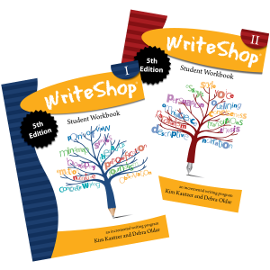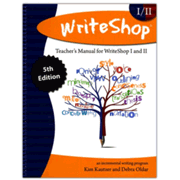WriteShop® I and II is a great resource for parents who lack confidence in their own ability to teach their students to write. The program's subtitle, “An Incremental Writing Program,” refers to the way it builds step by step on skills taught in previous lessons.
WriteShop I and II can be taught as a two-year program, or it can be completed at an accelerated pace in one year. It is ideal for students in grades seven through nine, but it should also work for bright sixth graders or for students in tenth grade and above who have not yet mastered the writing skills taught in WriteShop.
The authors have structured the lessons to build from the ground up, covering both the structure and style of sentences and paragraphs before tackling lengthier assignments. Because of this, you should not skip lessons or change their order.
The program is presented from one teacher's manual titled Teacher's Manual for WriteShop I and II, while students will use two workbooks: WriteShop I: Student Workbook and WriteShop II: Student Workbook. You can purchase either printed or digital books.
In WriteShop I, lessons in descriptive, informative, and narrative writing include describing a person, food, and place; explaining a process; writing a short report; and learning about tense, omniscience, and point of view in narratives. WriteShop II picks up where WriteShop I leaves off. Following a brief review, WriteShop II lessons cover advanced descriptive narration, point of view, narrative voice, and essay writing (including how to write a timed essay).
None of the writing assignments are very lengthy. High schoolers will need to practice writing lengthier compositions and research reports than are required by WriteShop. (Keep in mind that this program is not intended to cover all types of writing assignments. For example, there are no lessons on poetry or writing business letters.)
The program needs to be taught from the teacher’s manual. The teacher's manual provides detailed daily lesson plans and instructions for teachers to guide them through instruction, activities, evaluation, and grading. It takes the guesswork out of the process. The teacher's manual also has answer keys for "Skill Builder" worksheets (which I will describe later), instructions on how to edit and make comments, student writing samples, descriptions of typical student errors and probable solutions, reference pages, supplemental activity ideas, story starters, essay topics, and suggestions for writing based on what students are studying in other subject areas. (Those who want to use WriteShop in a class or co-op setting will probably want to get the Classroom Handbook: Teach WriteShop I & II in a Class or Co-Op.)
For each lesson, the student workbook has pages with instructional information, a brainstorming activity, Skill Builder exercises, and three checklists. The student workbooks also have reference information such as a chart of proofreading terms and symbols and a list of adverbs they might use to make their writing more interesting.
How It Works
If you are using the normal two-year schedule, the lessons are scheduled for four days each week, and each lesson should take about two weeks to complete. Lessons follow a predictable format most of the time. Lessons usually begin with Skill Builder exercises on the first three days, and these should take about 10 to 20 minutes per day.
Skill Builder pages in the student workbooks focus on the development of particular skills or knowledge, usually related to grammar or vocabulary. These activities give students an opportunity to practice skills they will use when they write their composition for that lesson. For example, the second lesson is “Describing a Pet.” The Skill Builder teaches students to use a thesaurus to come up with more-interesting words to replace overused adjectives and weak verbs. This skill is then incorporated into the pet description that students will write. Many of the grammar-oriented Skill Builders help students finally see the use of some of their grammar lessons.
Prewriting activities are warm-ups that should be done after the Skill Builder activity on the first day of each lesson. They involve discussion, interaction, and an occasional game.
The student workbook includes specific instructions about what will need to be included for each writing assignment students are preparing to tackle. Students will generally be required to follow a particular format, focusing on a certain type of content and incorporating particular types of words (e.g., sensory words, transition words, or colorful descriptions).
On the second day of each lesson, the teacher and students brainstorm and write a practice paragraph together. This models the process that students will use when they write their own paragraphs on the third day.
The teacher works with the student again on the third day, brainstorming as the student begins work on his or her own paragraph. (There is usually a brainstorming worksheet in the student workbook to help with this.) Students will write a "sloppy copy"—a rough draft of their paragraph.
On the fourth day, students will edit and revise their rough drafts. They will use the first of the three checklists—the Student Writing Skills Checklist—to check off items related to content, style, and mechanics. On day five, they will edit their writing by referring to the checklist they used the previous day. When this revision is done, they will turn in their composition.
On the sixth day, the teacher uses the second checklist—the Teacher Writing Skills Checklist—to give students feedback. The teacher will also edit using the same editing symbols and terms that are in the student workbook. (The student has a day off while their work is edited.) On the seventh day, students write their final version based on the feedback from their teacher. On the eighth day, the teacher evaluates the final draft using the third checklist, the Composition Evaluation. This form shows points awarded under the headings of content, style, mechanics, and general. There is also room on the page for written comments.
In addition to the lesson activities described above, copywork and dictation exercises each occur twice per two-week lesson cycle. The copying and dictation assignments help students develop skills of observation and attention as they work on various sentence constructions and encounter new vocabulary. WriteShop has published Copying and Dictation Exercises for WriteShop I, with excerpts from well-known literary works that relate to each of the sixteen lessons in WriteShop I. Teachers can use this to save having to come up with their own passages, but it is fine if you want to use something else. Prepared material for copying and dictation isn't available for WriteShop II, so you will have to come up with something on your own.
The authors recommended that students using WriteShop I and II have a grammar handbook for reference.
Summary
The program works well for parents working with one or more of their own children, but it also works well for a group class. Either way, it requires quite a bit of teaching time. Some lesson preparation time will be required if you need visual aids or other resources, but the lesson plans themselves are easy to follow.
Overall, WriteShop I and II is one of the best resources I've seen for group classes and for parents who need help teaching writing.
For students in grades K through 6, see my review of WriteShop Primary and WriteShop Junior.












